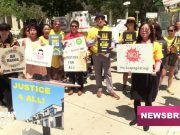In 1913 Richard E.S. Toomey would walk from Overtown, then known as Colored Town, to the Miami-Dade County Court House on Flagler Street to avoid being harassed on city streets.
He was heckled, harassed, and if the Ku Klux Klan was involved, much worse things could happen, so traveling the railroad track was safe… and the railroad track went almost immediately into Colored Town,” said H.T Smith, a professor of law at FIU and the founding president of the Wilkie D. Ferguson, Jr. Bar Association.
According to The Black Archives, the Miami Chamber of Commerce formally invited Toomey to establish his general practice in 1912 to serve the city’s Black community.
“There were no Black lawyers licensed in the state of Florida before Richard E.S. Toomey,” said Smith.
Paul S. George, a professor of history at Miami Dade College and historian at the HistoryMiami Museum, said Toomey opened doors for Black lawyers in Miami.
“Toomey set the path for Black legal professionals in Greater Miami; he really did,” said George. “He was a trailblazer, bright, and faced all kinds of obstacles.”
Smith said that the group invited Toomey because white attorneys would not help Black clients with everyday legal matters, such as divorce, changing their name or buying property. But even then it was a struggle.
“Because of stark racism and inhumanity of segregation, Toomey could not go into the bar with lawyers, and so he could not argue cases,” said Smith, referring to the part of the courtroom where attorneys would typically be. “When he went to court, he had to get a white lawyer… he would pay a white lawyer to read his argument.”
George said that Toomey also could not interrogate witnesses or speak to the jury.
“He served as sort of a legal adviser to a white attorney or attorneys who might have been involved in that case,” said George.
Smith said that Toomey offered his services at a lowered cost so that the community could afford them.
“The white lawyer was not free,” he said. “Toomey’s representing the poorest people in Miami, charging them as little as can be so that they can have the service, and he can just barely make a little bit of money.”
Smith said that Toomey made many sacrifices to be able to represent his community.
“He took that indignity, he took that discrimination, he took that disrespect to be able to provide passionate, powerful, persuasive representation to his people,” he said. “He suffered personally so that they would not suffer legally.”
George said that Toomey was a leader in the community and pushed for police reform in Colored Town.
“He was also very active as a civic leader,” said George. “As early as the 1910s, he was pushing hard for Black policemen in Colored Town because it was being patrolled by white policemen, who could be brutal.”
George said that Colored Town would not get their first Black policeman until 1944, about 25 years after Toomey had first called for them.
According to George’s article, “Policing Miami’s Black Community, 1896-1930,” racial tensions in Miami increased throughout the 1910s. The article stated that white chauffeurs would routinely chase away Black competition with threats and violence.
According to the article, the violence came to a head when a group of white men set off dynamite in the Odd Fellows Hall, the largest building in Colored Town. No suspects were ever arrested, and Black clergymen convinced Black people not to take up arms.
“The potential for racial violence, nonetheless, increased with the emergence of Negro organizations,” the article stated. “One of the most important of these groups was the Negro Uplift Association of Dade County.”
George said that Toomey was also the leader of a local Negro Uplift Association.
“He was the leader of that (the Negro Uplift Association),” said George. “That was the group that called for better housing and accommodations in Colored Town. So, he not only had a big hand as an attorney but also as a civic activist.”
Toomey was also a soldier and a renowned poet and orator. He was nicknamed “The Soldier Poet.”
He served during the Spanish-American War of 1898, where he was promoted to first lieutenant.
According to the Army Historical Foundation website, many people at the time believed that Southern Black people were immune to the tropical diseases in Cuba.
“Concerned about the health risks that tropical diseases would pose for American troops when they deployed to the Caribbean theater of operations, the War Department almost immediately began to consider organizing specialized units,” stated the site.
In 1902 Toomey became the second Black person to read at the Congressional Library, where he read from his book of poetry, “Thoughts for True Americans.”
Smith said that he believes that the Miami Chamber of Commerce discovered Toomey through his poetry and then his law career.
In 2014, Smith was the inaugural recipient of the Wilkie D. Ferguson, Jr. Bar Foundation’s Richard E.S. Toomey Legal Legacy Award.
Smith said that he intended to have The Black Lawyers Association change names to the Richard E.S. Toomey Bar Association. However, Wilkie D. Ferguson, Jr. died during the transition in 2003, so it was decided that The Black Lawyers Association would honor Ferguson.
“He (Ferguson) was a federal judge at the time, he was the first Black circuit court judge… he was a tremendous champion for the cause of equal justice for LGBT, for immigrants, for Blacks,” said Smith.
Smith acknowledged that there is still more research to be done about Toomey’s impact and that Ferguson’s career and impact are much better known.
“We have not researched all that Toomey did, but we know all that Wilkie did,” said Smith. “So we named the organization the Wilkie D. Ferguson, Jr. Bar Association.”
According to the association’s website, their mission is to promote Black lawyers’ goals in Miami-Dade County, raise commitment to the civil and political rights of the local Black community, and encourage positive change in the legal community.
Smith said that he discovered Toomey after graduating from the University of Miami Law School.
In his research, Smith found out that Toomey was buried at the Miami City Cemetery in the veteran’s section.
“My heart almost jumped out of my chest, and there it was, I saw his gravestone,” said Smith.
Smith said he and Jesse McCrary, a lawyer and the first Black Secretary of State of Florida, decided to raise money and build a headstone for Toomey.
“There was a wonderful ceremony,” said Smith. “Judges and lawyers, black and white, old and young… we dedicated that to Richard E.S. Toomey,” said Smith.
Smith said that he is developing a summer fellowship for Black law students to research Toomey’s cases, as there is little information available about specific cases Toomey worked on.
In addition to Toomey, the fellowship would also research the cases of Black lawyers in the 50s and 60s.
COVID-19 presented an obstacle, but Smith said he is hoping the fellowship will start this summer.
Smith highlighted the importance of carrying on Toomey’s legacy.
“I am hopeful that with the talents that God has given me that I am using them to advance the cause that he stood for,” said Smith. “But we all in our own way should be doing that.”
This story is part of series on the Miami City Cemetery































